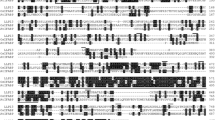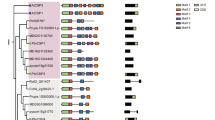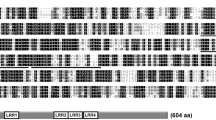Abstract
We have isolated a gene and cDNA from Brassica napus encoding a hybrid-proline-rich protein. The putative protein is modular in structure. The N-terminal domain has properties of a signal peptide which would direct the protein into the ER. Amino acids 27 to 287 comprise three domains which contain high levels of proline and several other amino acids common in proline-rich cell wall proteins. These domains are characterised by repeating amino acid motifs. The C-terminal domain (amino acids 288 to 376) contains three putative membrane-spanning regions and shows a high degree of amino acid similarity to known hybrid-proline-rich proteins from several species. It is likely that the protein is secreted from the cell, located in the cell wall and anchored in the plasma membrane via the C-terminal domain. Transcripts encoding this protein are induced in leaf tissue within 8 h of cold treatment and decrease rapidly when plants are returned to normal temperatures. The transcripts are not induced by heat shock, dehydration, exogenous ABA or wounding, whereas transcripts of a control B. napus gene are induced by dehydration and ABA. The possible function of this protein in cold tolerance is discussed.
Similar content being viewed by others
Abbreviations
- PRP:
-
proline-rich-protein
- RWC:
-
relative water content
References
Aleith A, Richter G: Gene expression during induction of somatic embryogenesis in carrot cell suspensions. Planta 183: 17–24 (1990).
Castonguay Y, Laberge S, Nadeau P, Vézina L-P: A cold-induced gene from Medicago sativa encodes a bimodular protein similar to developmentally regulated proteins. Plant Mol Biol 24: 799–804 (1994).
Cattivelli L, Bartels D: Molecular cloning and characterization of cold-regulated genes in barley. Plant Physiol 93: 1504–1510 (1990).
Chomczynski P, Sacchi N: Single-step method of RNA isolation by acid guanidinium thiocyanate-phenol-chloroform extraction. Anal Biochem 162: 156–159 (1987).
Chrispeels MJ: Sorting of proteins in the secretory system. Annu Rev Plant Physiol Plant Mol Biol 42: 21–53 (1991).
Coupe SA, Taylor JE, Isaac PG, Roberts JA: Identification and characterization of a proline-rich mRNA that accumulates during pod development in oilseed rape (Brassica napus L.). Plant Mol Biol 23: 1223–1232 (1993).
Datta N, LaFayette PR, Kroner PA, Nagao RT, Key JL: Isolation and characterization of three families of auxin down-regulated cDNA clones. Plant Mol Biol 21: 859–869 (1993).
Downing WL, Mauxion F, Fauvarque M-O, Reviron M-P, deVienne D, Vartanian N, Giraudat J: A Brassica napus transcript encoding a protein related to the Künitz protease inhibitor family accumulates upon water stress in leaves, not in seeds. Plant J 2: 685–693 (1992).
Dunn MA, Hughes MA, Pearce RS, Jack PL: Molecular characterization of a barley gene induced by cold treatment. J Exp Bot 41: 1405–1413 (1990).
Dunn MA, Hughes MA, Zhang L, Pearce RS, Quigley AS, Jack PL: Nucleotide sequence and molecular analysis of the low temperature induced cereal gene, blt4. Mol Gen Genet 229: 389–394 (1991).
Einfeld DA, Brown JP, Valentine MA, Clark EA, Ledbetter JA: Molecular cloning of the human B cell CD20 receptor predicts a hydrophobic protein with multiple transmembrane domains. EMBO J 7: 711–717 (1988).
Gilmour SJ, Thomashow MF: Cold acclimation and cold-regulated gene expression in ABA mutants of Arabidopsis thaliana. Plant Mol Biol 17: 1233–1240 (1991).
Guo W, Ward RW, Thomashow MF: Characterization of a cold-regulated wheat gene related to Arabidopsis cor47. Plant Physiol 100: 915–922 (1992).
Guy CL: Cold acclimation and freezing stress tolerance: role of protein metabolism. Annu Rev Plant Physiol Plant Mol Biol 41: 187–223 (1990).
Hajela RK, Horvath DP, Gilmour SJ, Thomashow MF: Molecular cloning and expression of cor (cold-regulated) genes in Arabidopsis thaliana. Plant Physiol 93: 1246–1252 (1990).
Houde M, Danyluk J, Laliberté J-F, Rassart E, Dhindsa RS, Sarhan F: Cloning, characterization, and expression of a cDNA encoding a 50-kilodalton protein specifically induced by cold acclimation in wheat. Plant Physiol 99: 1381–1387 (1992).
Howarth CJ, Ougham HJ: Gene expression under temperature stress. New Phytol 125: 1–26 (1993).
Hughes MA, Dunn MA: The molecular biology of plant acclimation to low temperature. J Exp Bot, in press (1996).
Hughes MA, Dunn MA, Pearce RS, White AJ, Zhang L: An abscisic-acid-responsive, low temperature barley gene has homology with a maize phospholipid transfer protein. Plant Cell Envir 15: 861–865 (1992).
Jarillo JA, Capel J, Leyva A, Martinez-Zapter JM, Salinas J: Two related low-temperature-inducible genes of Arabidopsis encode proteins showing high homology to 14–3–3 proteins, a family of putative kinase regulators. Plant Mol Biol 25: 693–704 (1994).
John I, Wang H, Held BM, Wurtele ES, Colbert JT: An mRNA that specifically accumulates in maize roots delineates a novel subset of developing cortical cells. Plant Mol Biol 20: 821–831 (1992).
Johnson-Flanagan AM, Singh J: Membrane deletion during plasmolysis in hardened and non-hardened plant cells. Plant Cell Envir 9: 299–305 (1986).
Johnson-Flanagan AM, Singh J: Alteration of gene expression during the induction of freezing tolerance in Brassica napus suspension cultures. Plant Physiol 85: 699–705 (1987).
José M, Puigdomènech P: Structure and expression of genes coding for structural proteins of the plant cell wall. New Phytol 125: 259–282 (1993).
José-Estanyol M, Ruiz-Avilla L, Puigdomènech P: A maize embryo-specific gene encodes a proline-rich and hydrophobic protein. Plant Cell 4: 413–423 (1992).
Joshi CP: Putative polyadenylation signals in nuclear genes of higher plants: a compilation and analysis. Nucl Acids Res 15: 9627–9639 (1987).
Kieliszewski MJ, Lamport DTA: Extensin: repetitive motifs, functional sites, post-translational codes, and phylogeny. Plant J 5: 157–172 (1994).
Knight MR, Campbell AK, Smith SM, Trewavas AJ: Transgenic plant aequorin reports the effects of touch and cold-shock and elicitors on cytoplasmic calcium. Nature 352: 524–526 (1991).
Krishna P, Sacco M, Cherutti JF, Hill S: Cold-induced accumulation of hsp90 transcripts in Brassica napus. Plant Physiol 107: 915–923 (1995).
Kurkela S, Franck M: Cloning and characterization of a cold- and ABA-inducible Arabidopsis gene. Plant Mol Biol 15: 137–144 (1990).
Kyte J, Doolittle RF: A simple method for displaying the hydropathic character of a protein. J Mol Biol 157: 105–132 (1982).
Meza-Basso L, Alberdi M, Raynal M, Ferrero-Cadinanos M-L, Delseny M: Changes in protein synthesis in rapeseed (Brassica napus) seedlings during a low temperature treatment. Plant Physiol 82: 733–738 (1986).
Mohapatra SS, Wolfraim L, Poole RJ, Dhindsa RS: Molecular cloning and relationship to freezing tolerance of cold-acclimation-specific genes of alfalfa. Plant Physiol 89: 375–380 (1989).
Monroy AF, Dhindsa RS: Low-temperature signal transduction: induction of cold acclimation-specific genes of alfalfa by calcium at 25 °C. Plant Cell 7: 321–331 (1995).
Neven LG, Haskell DW, Guy CL, Denslow N, Klein PA, Green LG, Silverman A: Association of 70-kilodalton heat-shock cognate proteins with acclimation to cold. Plant Physiol 99: 1362–1369 (1992).
Nordin K, Heino P, Palva ET: Separate signal pathways regulate the expression of a low-temperature-induced gene in Arabidopsis thaliana (L.) Heynh. Plant Mol Biol 16: 1061–1071 (1991).
Nordin K, Vahala T, Palva ET: Differential expression of two related, low-temperature-induced genes in Arabidopsis thaliana (L.) Heynh. Plant Mol Biol 21: 641–653 (1993).
Orr W, Keller WA, Singh J: Induction of freezing tolerance in an embryogenic cell suspension culture of Brassica napus by abscisic acid at room temperature. J Plant Physiol 126: 23–32 (1986).
Orr W, Iu B, White TC, Robert LS, Singh J: Complementary DNA sequence of a low temperature-induced Brassica napus gene with homology to the Arabidopsis thaliana Kin1 gene. Plant Physiol 98: 1532–1534 (1992).
Pallas JA: Ph.D thesis, University of Glasgow (1992).
Pearce RS: Extracellular ice and cell shape in frost-stressed cereal leaves: a low-temperature scanning-electron-microscopy study. Planta 175: 313–324 (1988).
Pearce RS, Ashworth EN: Cell shape and localisation of ice in leaves of overwintering wheat during frost stress in the field. Planta 188: 324–331 (1992).
Pont-Lezica RF, McNally JG, Pickard BG: Wall-to-membrane linkers in onion epidermis: some hypotheses. Plant Cell Envir 16: 111–123 (1993).
Ristic Z, Ashworth EN: Response of xylem ray parenchyma cells of red osier dogwood (Cornus sericea L.) to freezing stress. Plant Physiol 104: 737–746 (1994).
Sáez-Vásquez J, Raynal M, Meza-Basso L, Delseny M: Two related, low-temperature-induced genes from Brassica napus are homologous to the human tumour bbc1 (breast basic conserved) gene. Plant Mol Biol 23: 1211–1221 (1993).
Salts Y, Wachs R, Gruissem W, Barg R: Sequence coding for a novel proline-rich protein preferentially expressed in young tomato fruit. Plant Mol Biol 17: 149–150 (1991).
Sambrook J, Fritsch EF, Maniatis T: Molecular Cloning: A Laboratory Manual, 2nd ed. Cold Spring Harbor Laboratory Press, Cold Spring Harbor, NY (1989).
Schaffer MA, Fischer RL: Transcriptional activation by heat and cold of a thiol protease gene in tomato. Plant Physiol 93: 1486–1491 (1990).
Shirras AD, Northcote DH: Molecular cloning and characterisation of cDNAs complementary to mRNAs from wounded potato (Solanum tuberosum) tuber tissue. Planta 162: 353–360 (1984).
Showalter AM: Structure and function of plant cell wall proteins. Plant Cell 5: 9–23 (1993).
Thomashow MF: Molecular genetics of cold acclimation in higher plants. Adv Genet 28: 99–131 (1990).
Thomashow MF: Genes induced during cold acclimation in higher plants. In: Steponkus PL (ed) Advances in Low Temperature Biology, vol 2. pp. 183–210. JAI Press, London (1993).
vanBerkel J, Salamini F, Gebhardt C: Transcripts accumulating during cold storage of potato (Solanum tuberosum L.) tubers are sequence related to stress-responsive genes. Plant Physiol 104: 445–452 (1994).
vanZee K, Chen FQ, Hayes PM, Close TJ, Chen THH: Cold-specific induction of a dehydrin gene family member in barley. Plant Physiol 108: 1233–1239 (1995).
Vitale A, Ceriotti A, Denecke J: The role of the endoplasmic reticulum in protein synthesis. modification and intracellular transport. J Exp Bot 44: 1417–1444 (1993).
vonHeijne G: Transcending the impenetrable: how proteins come to terms with membranes. Biochim Biophys Acta 947: 307–333 (1988).
Weretilnyk E, Orr W, White TC, Iu B, Singh J: Characterization of three low-temperature-regulated cDNAs from winter Brassica napus. Plant Physiol 101: 171–177 (1993).
White AJ, Dunn MA, Brown K, Hughes MA: Comparative analysis of genomic sequence and expression of a lipid transfer protein gene family in winter barley. J Exp Bot 45: 1885–1892 (1994).
White TC, Simmonds D, Donaldson P, Singh J: Regulation of BN115, a low-temperature-responsive gene from winter Brassica napus. Plant Physiol 106: 917–928 (1994).
Zhang L, Dunn MA, Pearce RS, Hughes MA: Analysis of organ specificity of a low temperature responsive gene family in rye (Secale cereale L.) J Exp Bot 44: 1787–1793 (1993).
Author information
Authors and Affiliations
Rights and permissions
About this article
Cite this article
Goodwin, W., Pallas, J.A. & Jenkins, G.I. Transcripts of a gene encoding a putative cell wall-plasma membrane linker protein are specifically cold-induced in Brassica napus . Plant Mol Biol 31, 771–781 (1996). https://doi.org/10.1007/BF00019465
Received:
Accepted:
Issue Date:
DOI: https://doi.org/10.1007/BF00019465




